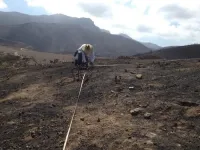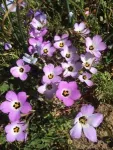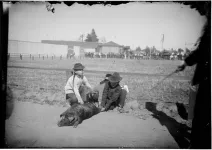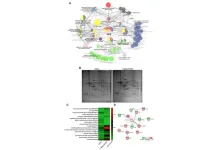(Press-News.org) Springtime brings native wildflowers to bloom in the Santa Monica Mountains, northwest of Los Angeles. These beauties provide food for insects, maintain healthy soil and filter water seeping into the ground — in addition to offering breathtaking displays of color.
They’re also good at surviving after wildfire, having adapted to it through millennia. But new research shows wildflowers that usually would burst back after a blaze and a good rain are losing out to the long-standing, double threat of city smog and nonnative weeds.
A recent study led by Justin Valliere, assistant professor in the UC Davis Department of Plant Sciences, found that native wildflowers and other plants that typically flourish following a fire were, instead, replaced by invasive plants on land that received the kind of nitrogen contained in vehicle emissions.
“Many native plants in fire-prone areas rely on fire, and some are entirely dependent on it. Some are even most abundant after a fire,” Valliere said. “But we found that these fire-following species may be especially vulnerable to the combination of nitrogen pollution and invasive plants.”
That’s part of the reason native plants in these mountains have been declining.
Seeds banked, waiting to sprout
The problem faced by native plants can be likened to a drawn-down bank account: Funds withdrawn are not being replaced.
It starts with fire, an important ecological process, Valliere said. Flames burn through plants on the surface and return their nutrients to the soil. Seeds sleeping in the ground wait for the next rain to sprout, then use those nutrients to grow.
“Plant diversity is often highest in growing seasons immediately after a site burns,” he said.
But invading plants have many advantages over native ones. They often sprout earlier, grow faster and create more seeds, all while tolerating drought.
“They’re like cheaters,” Valliere said. “They don’t follow the same rules.”
Nitrogen, too, is an important piece of every plant’s nutrition. They get a fertilizing boost from nitrogen that floats up in vehicle emissions and falls to the ground. But the invaders use nitrogen and other nutrients to grow faster, winning the race for water and sunlight. As a result, fewer native plants reach maturity, producing fewer seeds that keep their populations thriving.
When the account balance reaches zero
The 2013 Springs Fire gave Valliere a unique opportunity to study the combined impacts of wildfire and extra nitrogen. He and colleagues from UC Riverside and the National Park Service created test plots in the Santa Monica Mountains where the fire had burned. Then, they added nitrogen to the soil to mimic the amount and type that L.A.’s smog would deposit. Over the study’s three years, native plants that typically would have flourished after wildfire instead declined even faster in the plots with added nitrogen.
Native seeds sprouted but didn’t flower. Over time, the soil’s bank of seeds drew down.
“Each seed has one chance to flower and reproduce,” Valliere said. “If a seed grows and gets outcompeted, that seed has lost its chance to replenish the seed bank.”
Without the chance to replenish their bank account, native plants will die out, and the ecosystem will be thrown out of balance.
“There is inherent value in biodiversity,” Valliere said. “These invasive weeds could prevent the re-establishment of native shrubs after fire, sometimes forever altering the plant community.”
The loss of native plants can have cascading effects on the larger environment. Problems can include the loss of native bees that feed on the flowers, and mudslides when rain makes hillsides unstable.
In similar areas where biodiversity flourishes after wildfires — including parts of the Mediterranean basin, southern Africa and Australia — air pollution also threatens native vegetation.
The addition of city smog “could have serious consequences for the biodiversity of fire-prone ecosystems worldwide,” Valliere warned.
The study was funded by the National Park Service’s Air Resources Division and the Bloom-Hayes Ecological Research Grant.
Co-authors include Irina Irvine of the National Park Service and Edith Allen of UC Riverside.
END
Car fumes, weeds pose double whammy for fire-loving native plants
Wildflower displays threatened
2024-02-15
ELSE PRESS RELEASES FROM THIS DATE:
How Chinese migrants in Los Angeles Chinatown gained self-reliance
2024-02-15
In the late 1800s and early 1900s, anti-Chinese sentiment in the United States was high, as working-class laborers in the country viewed Chinese workers as a threat.
Prior research has found that during that period, approximately 400,000 Chinese migrants came to the U.S., many of whom went to California to build the Transcontinental Railroad. Following the project's completion, competition for jobs grew tougher, and passage of the Chinese Exclusion Act in 1882 banned Chinese laborers from immigrating to the U.S.
But ...
New study by researchers at UNC-Chapel Hill finds chemical composition of US air pollution changed over time
2024-02-15
A new study published in Atmospheric Environment by researchers at the University of North Carolina at Chapel Hill analyzed space and time trends for fine particulate matter (PM2.5) in the continental United States to track the progress of regulatory actions by federal, state and local authorities aimed at curbing air pollution. The team found that while the annual average concentration for PM2.5 had been significantly reduced, its chemical composition had changed during the study period of 2006 to 2020. Their analysis suggests targeted strategies to reduce specific pollutants for different regions ...
ASHG names Amanda Perl as Chief Executive Officer
2024-02-15
For Immediate Release: Thursday, February 15, 2024, 3:00pm U.S. Eastern Time
Media Contact: Kara Flynn, 202.257.8424, press@ashg.org
ROCKVILLE, MD - The American Society of Human Genetics (ASHG) is excited to announce the selection of Amanda Perl as the organization’s next Chief Executive Officer. Perl has served in numerous association leadership positions with deep experience in strategic planning, membership, publishing, communications, and society operations, as well as meetings and conferences.
“ASHG is delighted to welcome Amanda, a seasoned association executive, to the team,” said ASHG President Bruce D. Gelb, MD. “We are confident ...
GV1001 reduces neurodegeneration and prolongs lifespan in mouse model of Alzheimer’s disease
2024-02-15
“[...] accelerated aging and Alzheimer’s disease are closely related, and this study confirmed that GV1001 has multiple anti-aging effects.”
BUFFALO, NY- February 15, 2024 – A new research paper was published on the cover of Aging (listed by MEDLINE/PubMed as "Aging (Albany NY)" and "Aging-US" by Web of Science) Volume 16, Issue 3, entitled, “GV1001 reduces neurodegeneration and prolongs lifespan in 3xTg-AD mouse model through anti-aging effects.”
GV1001, which mimics the activity of human telomerase reverse transcriptase, protects neural cells from amyloid beta (Aβ) toxicity and other stressors through ...
Study: Ablative stereotactic magnetic resonance-guided adaptive radiation therapy may improve overall survival in patients with pancreatic cancer
2024-02-15
MIAMI, FL – February 15, 2024 – A study co-led by researchers at Miami Cancer Institute, part of Baptist Health South Florida, found that ablative stereotactic magnetic resonance (MR)-guided adaptive radiation therapy may improve local control (LC) and overall survival (OS) in patients with borderline resectable (BRPC) and locally advanced pancreas cancer (LAPC). Long-term outcomes from the Phase 2 SMART trial demonstrate encouraging OS and limited toxicity as published recently in Radiotherapy & Oncology (“The Green Journal”).
“Pancreatic ductal adenocarcinoma is a leading cause of cancer death. Surgery is the only known ...
Discovery of new Li ion conductor unlocks new direction for sustainable batteries
2024-02-15
One of the grand challenges for materials science is the design and discovery of new materials that address global priorities such as Net Zero.
In a paper published in the journal Science, researchers at the University of Liverpool have discovered a solid material that rapidly conducts lithium ions. Such lithium electrolytes are essential components in the rechargeable batteries that power electric vehicles and many electronic devices.
Consisting of non-toxic earth-abundant elements, the new material has high ...
Unearthed: Why zebra go first in body-size-dependent grazing succession in the Serengeti
2024-02-15
Why do Serengeti zebra, wildebeest, and gazelle – all sharing limited food resources – follow the same migratory routes, one after another, in a body-size dependent way? This longstanding question has now been evaluated by researchers who used novel data to show how a balance of species interactions and ecological factors regulate this process. They say competition pushes zebra ahead of the wildebeest, and wildebeest then eat plants in a way that facilitates development of newer growth the trailing gazelle like. “Our results highlight a balance between facilitative and competitive forces,” the authors say. Large seasonal migrations are a ...
Oxygen increased in the tropical ocean during the Paleocene-Eocene Thermal Maximum
2024-02-15
Oxygenation in the tropical North Pacific Ocean increased during a warm climatic interval that occurred roughly 56 million years ago, despite high global temperatures, according to a new study. Its findings offer insights into how modern tropical oceans may respond to ongoing anthropogenic climate warming. The availability and distribution of dissolved oxygen in Earth’s oceans play a fundamental role in supporting marine ecosystems and marine life. However, oxygen in the global oceans is declining in response to anthropogenic warming. Although these trends writ large are predicted to continue, the future of oxygen in the highly productive ...
Introducing Cresomycin, a synthetic antimicrobial molecule highly effective against multidrug-resistant bacteria
2024-02-15
Cresomycin – a novel synthetic molecule – demonstrates remarkably robust efficacy against multiple, evolutionary divergent forms of antimicrobial resistance (AMR), researchers report. The emergence and widespread distribution of bacteria broadly resistant to approved antibiotics raises serious global public health concerns. Given the growing rate of deaths attributable to antimicrobial resistance (AMR) worldwide, it’s evident the pace of discovery and development of antibiotics effective against AMR has not kept up with the need. Many small ...
Prizewinner’s research unveils STING as a pivotal immune sensor channel
2024-02-15
For his work in furthering the understanding of how the human immune system senses dangerous invading pathogens, Bingxu Li has received the 2024 Michelson Philanthropies & Science Prize for Immunology. Li’s prize-winning essay investigates the role that Stimulator of Interferon Genes, or STING, plays in including multiple distinct defenses against viruses, bacteria, and tumors and in orchestrating myriad downstream responses upon activation – resolving a significant mystery in the field of innate immunity. The sensing and clearance of invading pathogens ...
LAST 30 PRESS RELEASES:
Longest observation of an active solar region
Why nail-biting, procrastination and other self-sabotaging behaviors are rooted in survival instincts
Regional variations in mechanical properties of porcine leptomeninges
Artificial empathy in therapy and healthcare: advancements in interpersonal interaction technologies
Why some brains switch gears more efficiently than others
UVA’s Jundong Li wins ICDM’S 2025 Tao Li Award for data mining, machine learning
UVA’s low-power, high-performance computer power player Mircea Stan earns National Academy of Inventors fellowship
Not playing by the rules: USU researcher explores filamentous algae dynamics in rivers
Do our body clocks influence our risk of dementia?
Anthropologists offer new evidence of bipedalism in long-debated fossil discovery
Safer receipt paper from wood
Dosage-sensitive genes suggest no whole-genome duplications in ancestral angiosperm
First ancient human herpesvirus genomes document their deep history with humans
Why Some Bacteria Survive Antibiotics and How to Stop Them - New study reveals that bacteria can survive antibiotic treatment through two fundamentally different “shutdown modes”
UCLA study links scar healing to dangerous placenta condition
CHANGE-seq-BE finds off-target changes in the genome from base editors
The Journal of Nuclear Medicine Ahead-of-Print Tip Sheet: January 2, 2026
Delayed or absent first dose of measles, mumps, and rubella vaccination
Trends in US preterm birth rates by household income and race and ethnicity
Study identifies potential biomarker linked to progression and brain inflammation in multiple sclerosis
Many mothers in Norway do not show up for postnatal check-ups
Researchers want to find out why quick clay is so unstable
Superradiant spins show teamwork at the quantum scale
Cleveland Clinic Research links tumor bacteria to immunotherapy resistance in head and neck cancer
First Editorial of 2026: Resisting AI slop
Joint ground- and space-based observations reveal Saturn-mass rogue planet
Inheritable genetic variant offers protection against blood cancer risk and progression
Pigs settled Pacific islands alongside early human voyagers
A Coral reef’s daily pulse reshapes microbes in surrounding waters
EAST Tokamak experiments exceed plasma density limit, offering new approach to fusion ignition
[Press-News.org] Car fumes, weeds pose double whammy for fire-loving native plantsWildflower displays threatened





